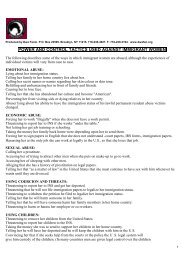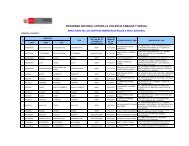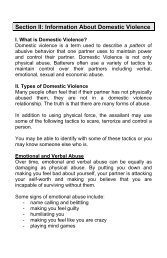Domestic Violence Counseling Manual - Hot Peach Pages
Domestic Violence Counseling Manual - Hot Peach Pages
Domestic Violence Counseling Manual - Hot Peach Pages
Create successful ePaper yourself
Turn your PDF publications into a flip-book with our unique Google optimized e-Paper software.
• Symptoms / Detection: Some people develop symptoms shortly after being infected. On<br />
average, it takes more than 10 years. There are several stages of HIV disease. The first<br />
symptom of HIV disease is often swollen lymph glands in the throat, armpit, or groin. Other<br />
early symptoms include slight fever, headaches, fatigue, muscle aches, and swollen glands.<br />
They may only last for a few weeks. Then there are usually no symptoms for many years.<br />
• Emergence of AIDS: HIV eventually causes AIDS, which is characterized by the<br />
development of multiple opportunistic infections such as Kaposi’s sarcoma, lymphoma and<br />
cervical cancer. The HIV antibody test is used to detect HIV. It takes the body several<br />
months to begin making the antibodies that this test detects. An individual who is concerned<br />
about HIV should wait about six months after possible exposure before being tested. A<br />
follow up test six month after this initial one is also recommended.<br />
• Treatment: There is no known treatment for HIV or AIDS. Anti-viral medication, such as<br />
AZT, has been extremely effective in warding off the symptoms of AIDS and allowing the<br />
immune system to continue functioning. These treatments also slow the process by which<br />
HIV becomes AIDS.<br />
2. Chlamydia<br />
Chlamydia is a sexually transmitted infection caused by the chlamydia trachomatis bacteria, which<br />
can infect the penis, vagina, cervix, anus, urethra, or eye. It is curable.<br />
• Transmission: Chlamydia is transmitted through vaginal, anal, or oral intercourse. Even an<br />
asymptomatic partner can transmit it. A condom can prevent the transmission of this disease.<br />
• Symptoms / Detection: Usually, chlamydia has no symptoms. Up to 85 percent of women and<br />
40 percent of men with chlamydia have no symptoms. Most people are not aware that they have<br />
the infection. When symptoms do occur, they may begin in as little as 5-10 days after infection.<br />
When women have symptoms, they may experience bleeding between menstrual periods, vaginal<br />
bleeding after intercourse, abdominal pain, painful intercourse, low-grade fever, painful urination,<br />
the urge to urinate more than usual, cervical inflammation, abnormal vaginal discharge,<br />
mucopurulent cervicitis (MPC) — a yellowish discharge from the cervix that may have a foul<br />
odor. When men have symptoms, they may experience, pus or watery or milky discharge from<br />
the penis, pain or burning feeling while urinating, swollen or tender testicles. These symptoms are<br />
like the symptoms of gonorrhea. They are called nongonococcal urethritis (NGU). Men often<br />
don't take these symptoms seriously because the symptoms may appear only early in the day and<br />
can be very mild. In women and men, chlamydia may cause the rectum to itch and bleed. It can<br />
also result in a discharge and diarrhea. If it infects the eyes, chlamydia may cause redness,<br />
itching, and a discharge.<br />
• Treatment: Antibiotics effectively cure chlamydia.<br />
39-56

















